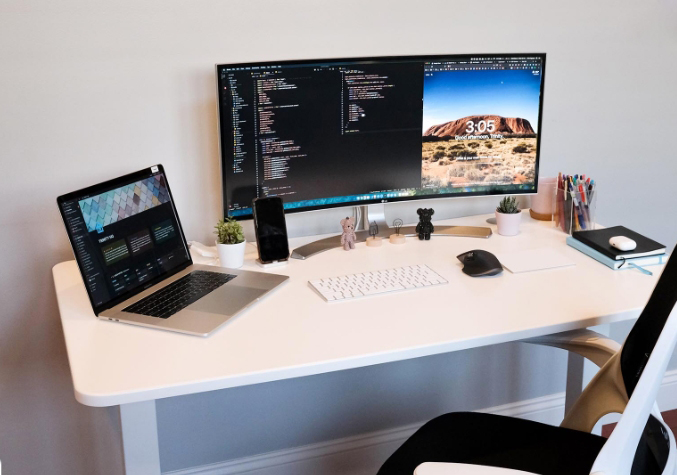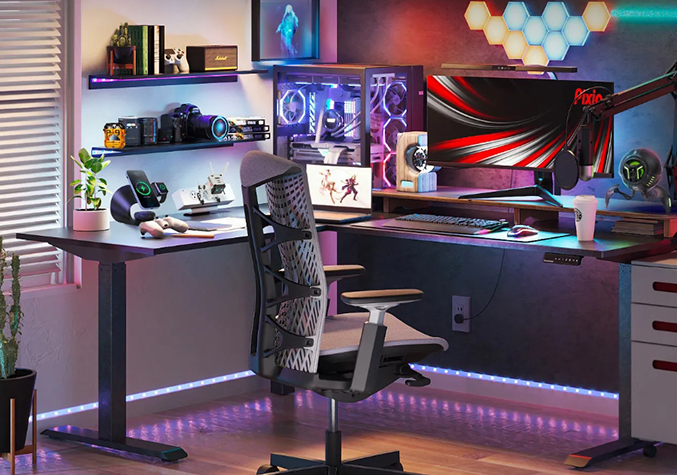Fitting two monitors on a tiny computer desk can be challenging, but with some strategic planning and adjustments, it's entirely possible. Here’s a guide on how to optimize your small desk space to accommodate two monitors:
1. Choose the Right Monitors
- Size: Opt for smaller monitors, such as 21-24 inches, which provide ample screen space without taking up too much physical space.
- Thin Bezels: Monitors with thin bezels reduce the gap between screens, making the setup more seamless and compact.
2. Use Monitor Mounts
- Dual Monitor Stand: Invest in a dual monitor stand that holds both monitors on a single base. This reduces the amount of desk space used compared to individual stands.
- Monitor Arms: Consider using adjustable monitor arms that clamp to the back or side of the desk. This frees up the desk surface and allows for flexible positioning of the monitors.
- Wall Mounts: If possible, mount the monitors on the wall behind your desk to completely free up the desk surface.

3. Optimize Desk Layout
- Corner Placement: If your desk is in a corner, place the monitors at an angle to maximize the available space and improve viewing comfort.
- Stacking Monitors: For an alternative setup, you can stack one monitor on top of the other using a vertical dual monitor stand or wall mounts. This setup requires good neck ergonomics, so it may not be ideal for everyone.
- Laptop Stand: If one of your monitors is a laptop, use a vertical laptop stand to minimize the desk space it occupies.

4. Desk Organization
- Declutter: Remove unnecessary items from your desk to maximize available space. Keep only essential items like your keyboard, mouse, and notepad.
- Cable Management: Use cable organizers, clips, or sleeves to keep cables tidy and out of the way. This reduces clutter and makes the desk look more spacious.
- Keyboard and Mouse Placement: Use a compact keyboard and mouse to save space. Consider a wireless setup to reduce cable clutter.
5. Adjust Monitor Placement
- Side-by-Side Setup: Place the monitors side by side, slightly angled inward to create a curved setup that fits better on a small desk.
- Overlapping Bases: If using the original monitor stands, position the bases so they overlap or slightly offset to save space.
- Height Adjustment: Ensure both monitors are at the same height to avoid neck strain. Use monitor stands or risers if needed.
6. Ergonomic Considerations
- Eye Level: Position the top of the monitors at or just below eye level to maintain good posture.
- Distance: Place the monitors at an arm’s length distance to reduce eye strain.
- Angle: Angle the monitors slightly inward to create a more comfortable viewing experience.
7. Additional Tips
- Compact Desk Accessories: Use compact desk accessories such as a small lamp, pen holder, or desk organizer to save space.
- Floating Desk: If space allows, consider installing a floating desk with no legs, which can provide more legroom and additional storage underneath.
- Under-Desk Storage: Utilize under-desk storage solutions like drawers or shelves to keep the desktop clear.
Example Layouts
1. Side-by-Side with Monitor Arm:
- Attach a dual monitor arm to the back of the desk.
- Position the monitors side by side with a slight inward angle.
- Keep the keyboard and mouse centered below the monitors.
2. Vertical Stacking:
- Use a vertical dual monitor stand or wall mounts to stack one monitor above the other.
- Adjust the height so the top monitor is not too high.
- Keep the keyboard and mouse directly in front of the lower monitor.
3. Corner Desk Setup:
- Place the desk in a corner of the room.
- Position the monitors at an angle, meeting at the corner point.
- This maximizes desk surface and improves viewing angles.
Conclusion
Fitting two monitors on a tiny computer desk requires thoughtful planning and optimization. By choosing the right monitors, utilizing mounts, organizing your desk, and considering ergonomic principles, you can create an efficient and comfortable dual-monitor setup even in a limited space.

